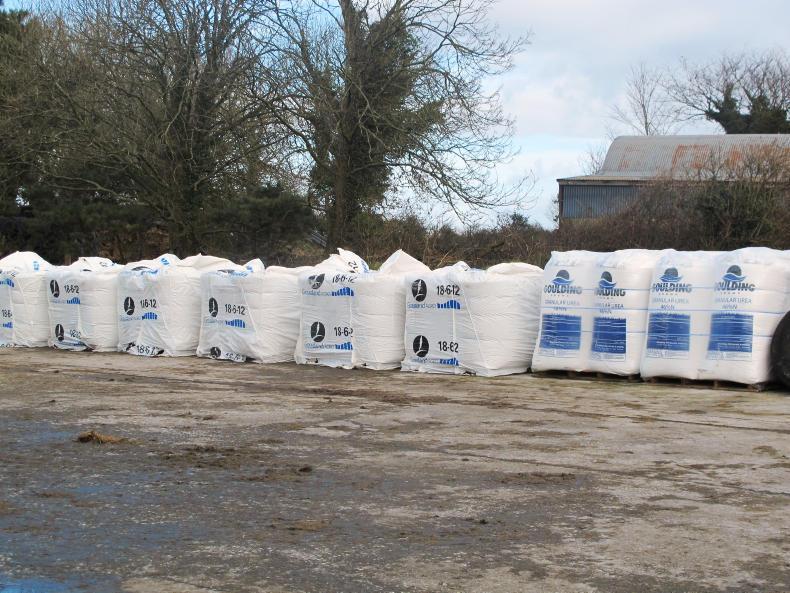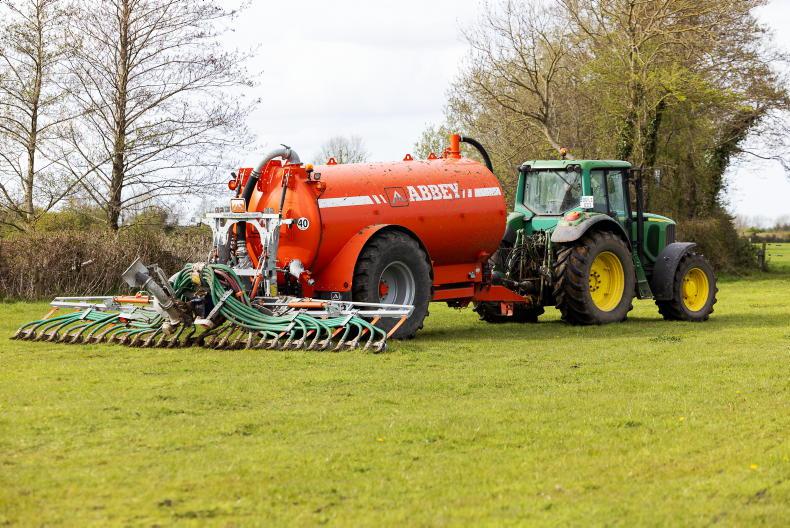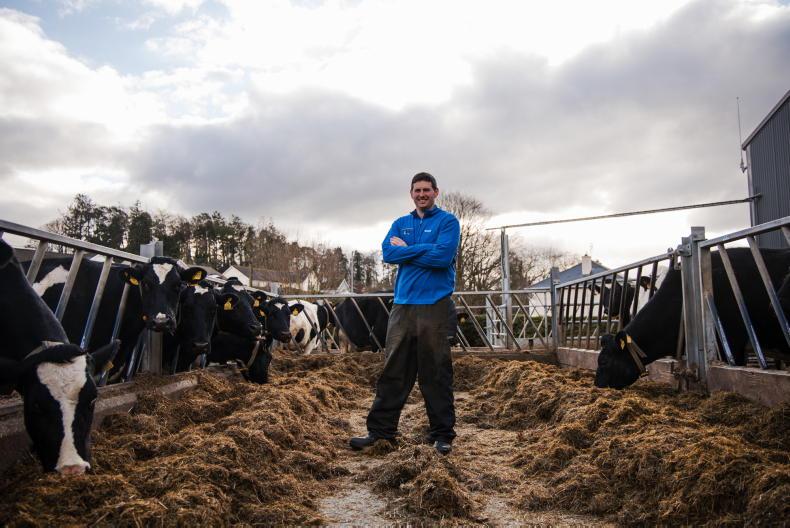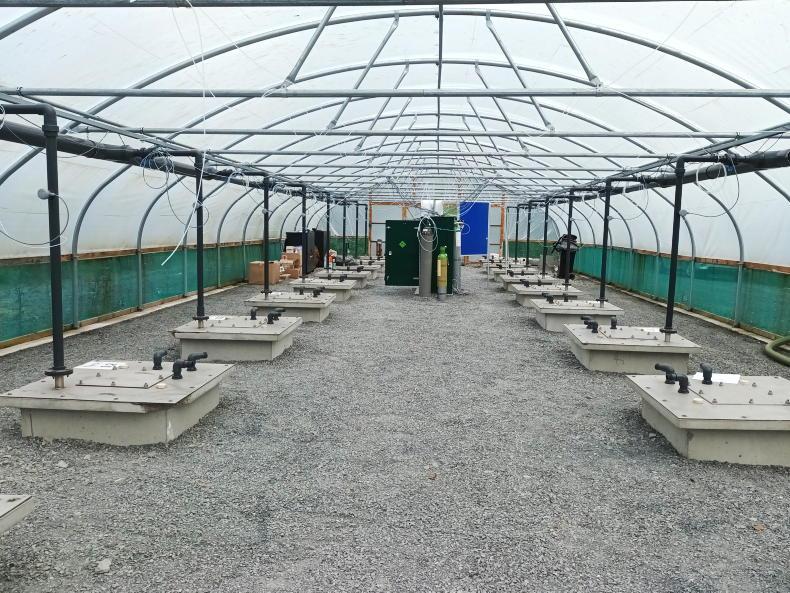Some intensive livestock farmers will be able to significantly step up phosphate fertiliser rates, and grow more grass, under the new Nitrates Action Programme, which is due to start next year.
The programme is out in draft form with final comments invited by Tuesday 28 November.
Any further amendments are unlikely to be major.
Maximum P rates for other farmers are left unchanged on the 2014-2017 programme.
Maximum rates of N fertiliser are unchanged.
Winter cereal growers will be allowed apply some of their P fertiliser in the autumn – lack of early P is cutting yield in these crops.
Other changes: farmers can no longer allow cattle drink from streams, after 2021, or let dirty water run off a farm roadway to a watercourse. For some farmers this will involve adjustment to farm roadways.
On farms stocked above 170kg N/ha, cattle will have to be fenced 1.5 metres out from watercourses
These new requirements will not cost farmers a lot of money but will increase the blood pressure of farmers who already feel weighed down by complex rules.
Farmers will have to soil-test more frequently.
This will cost them money but give a more accurate picture of soil fertility. Despite farmer frustration, there are no changes to cut-off dates for spreading slurry and manure.
The new programme has been drawn up jointly by the Departments of Agriculture and Housing, Planning and Local Government. Changes are based on recommendations from an expert group, which reviewed the outgoing programme as well as some two-dozen submissions.
These came from the farm organisations, EPA, Teagasc, a number of county councils, Inland Fisheries Ireland and other interested individuals and organisations.
The group said that its proposals are aimed at both strengthening the protection of water but also attaining optimum soil fertility. Proper fertility is consistent with both efficient agricultural production and effective water quality protection, it said.
Building up P levels
This is a notable change. More P fertiliser can be applied where it is needed, ie where stocking rates are high with more mouths to feed, but where P levels, and therefore grass growth, are sub-optimal.
Build-up rates can only be used where stocking rate is 130kg N per hectare or higher and on soils which are index 1 or 2 for P. The additional P amount is 50kg/ha on index 1 and 30kg/ha on index 2 soils.

For example, where a soil is index 2 and stocking rate is 131 to 170kg N per hectare, the maximum rate of P that can be used is 23kg. However, a farmer availing of the build-up measure will be able to use 43kg.
The change will facilitate expanding dairy farmers. There are safeguards to avoid damage to watercourses.
The farmer will have to use the services of a farm adviser, soil testing must be carried out and a farm nutrient management plan submitted to the Department of Agriculture. The farmer must participate in the Knowledge Transfer Scheme.
The review group explained its recommendations on P build-up. Previous programmes reduced the proportion of land with high P levels. However, the proportion of soils at soil P index 1 and 2 also increased. This decline in soil P, combined with sub-optimal soil potassium (K) and pH levels has resulted in only 10% of Irish soils having optimum fertility status.
The build-up rates are set at 80% of the rates required to build soil P levels to index 3 over the four-year programme. The review group estimated that around 3,000 farmers would avail of the P build-up, meaning there would be a negligible impact on national P usage.
Maximum application rates of P and nitrogen
The draft programme has new figures for maximum application of N and P fertilisers but in fact the effective rates are unchanged. The formula used in previous programmes was too complex and has been simplified. After a decade of torturing farmers, the final straw was when it emerged at staff training that Department of Agriculture officials and planners also found it too complicated.
Fencing cattle out of
watercourses
On farms stocked above 170kg N/ha, cattle will have to be fenced 1.5 metres out from watercourses. This will have to be done by 1 January 2021. It applies to more heavily stocked land on the basis that more animals equals more nutrient pressure.
If electric fencing can be used to exclude cattle from watercourses, this will not be a very costly requirement for most farmers. But some farmers will have to invest in water supply and drinkers on outfarms.
Keeping troughs away from water
Drinking points will have to be at least 20m away from a watercourse, where the farm is stocked at over 170kg/ha. Ground around drinking points can become poached and nutrients can enter a watercourse if it’s nearby.

No run-off from roadways to water
Farmers will have to ensure that any run-off from a farm roadway does not enter a watercourse. This may require modification of some roadways by earth bunding or changing camber to direct dirty water away from a watercourse, etc.
More frequent soil testing
Soil analysis results will be valid for four years, a reduction from the current six years. There must be one test per 5ha instead of every 8ha currently.
Poaching
Farmers will be required to avoid poaching that would result in run-off of dirty, nutrient-rich water to a watercourse.

Farmer behaviour
The review group said that a change in farmer behaviour is needed to achieve sustainable farming practices.
There is evidence of poor understanding of the Good Agricultural Practices regulations among farmers. Consideration should be given to establishing a unit of sustainability advisers.
Autumn P on cereals
Application of 20kg/ha of P up to a cut-off date of 31 October will be allowed when drilling winter cereal. This is a mere a change of timing, not an increase in P allowance.
Currently, the deadline is 15 September but most winter cereals are drilled after this deadline.
The expert group noted that this was likely to restrict early growth of crops, particularly on index 1 or 2 soils.
Closed periods for spreading
The draft programme does not extend the spreading season for slurry or manure or introduce new flexibility.
Closed periods are a fundamental requirement of the EU directive, the expert group noted.
“The group were of the opinion that any changing or relaxing of closed periods would need to be supported by science,” it concluded.
“Having considered all information available to it, the group concluded that no scientific justification had been provided to support increased flexibility in the prohibited period.”
The IFA is currently preparing a response to the draft regulation, which it will submit before the 28 November deadline. When making its submission to the expert group, IFA president Joe Healy said that low farm incomes and heavy regulation had resulted in soil fertility declining.
The new programme, he said, must provide a real opportunity to reverse declining soil fertility levels and ensure Ireland’s farming sector is well positioned to sustainably grow agri-food exports over the next decade.
Read more
Farmers reminded of nitrates form deadline
River fencing and roadways run-off in draft nitrates regulation
Nitrates Action Programme needs to deliver for farmers
Some intensive livestock farmers will be able to significantly step up phosphate fertiliser rates, and grow more grass, under the new Nitrates Action Programme, which is due to start next year.
The programme is out in draft form with final comments invited by Tuesday 28 November.
Any further amendments are unlikely to be major.
Maximum P rates for other farmers are left unchanged on the 2014-2017 programme.
Maximum rates of N fertiliser are unchanged.
Winter cereal growers will be allowed apply some of their P fertiliser in the autumn – lack of early P is cutting yield in these crops.
Other changes: farmers can no longer allow cattle drink from streams, after 2021, or let dirty water run off a farm roadway to a watercourse. For some farmers this will involve adjustment to farm roadways.
On farms stocked above 170kg N/ha, cattle will have to be fenced 1.5 metres out from watercourses
These new requirements will not cost farmers a lot of money but will increase the blood pressure of farmers who already feel weighed down by complex rules.
Farmers will have to soil-test more frequently.
This will cost them money but give a more accurate picture of soil fertility. Despite farmer frustration, there are no changes to cut-off dates for spreading slurry and manure.
The new programme has been drawn up jointly by the Departments of Agriculture and Housing, Planning and Local Government. Changes are based on recommendations from an expert group, which reviewed the outgoing programme as well as some two-dozen submissions.
These came from the farm organisations, EPA, Teagasc, a number of county councils, Inland Fisheries Ireland and other interested individuals and organisations.
The group said that its proposals are aimed at both strengthening the protection of water but also attaining optimum soil fertility. Proper fertility is consistent with both efficient agricultural production and effective water quality protection, it said.
Building up P levels
This is a notable change. More P fertiliser can be applied where it is needed, ie where stocking rates are high with more mouths to feed, but where P levels, and therefore grass growth, are sub-optimal.
Build-up rates can only be used where stocking rate is 130kg N per hectare or higher and on soils which are index 1 or 2 for P. The additional P amount is 50kg/ha on index 1 and 30kg/ha on index 2 soils.

For example, where a soil is index 2 and stocking rate is 131 to 170kg N per hectare, the maximum rate of P that can be used is 23kg. However, a farmer availing of the build-up measure will be able to use 43kg.
The change will facilitate expanding dairy farmers. There are safeguards to avoid damage to watercourses.
The farmer will have to use the services of a farm adviser, soil testing must be carried out and a farm nutrient management plan submitted to the Department of Agriculture. The farmer must participate in the Knowledge Transfer Scheme.
The review group explained its recommendations on P build-up. Previous programmes reduced the proportion of land with high P levels. However, the proportion of soils at soil P index 1 and 2 also increased. This decline in soil P, combined with sub-optimal soil potassium (K) and pH levels has resulted in only 10% of Irish soils having optimum fertility status.
The build-up rates are set at 80% of the rates required to build soil P levels to index 3 over the four-year programme. The review group estimated that around 3,000 farmers would avail of the P build-up, meaning there would be a negligible impact on national P usage.
Maximum application rates of P and nitrogen
The draft programme has new figures for maximum application of N and P fertilisers but in fact the effective rates are unchanged. The formula used in previous programmes was too complex and has been simplified. After a decade of torturing farmers, the final straw was when it emerged at staff training that Department of Agriculture officials and planners also found it too complicated.
Fencing cattle out of
watercourses
On farms stocked above 170kg N/ha, cattle will have to be fenced 1.5 metres out from watercourses. This will have to be done by 1 January 2021. It applies to more heavily stocked land on the basis that more animals equals more nutrient pressure.
If electric fencing can be used to exclude cattle from watercourses, this will not be a very costly requirement for most farmers. But some farmers will have to invest in water supply and drinkers on outfarms.
Keeping troughs away from water
Drinking points will have to be at least 20m away from a watercourse, where the farm is stocked at over 170kg/ha. Ground around drinking points can become poached and nutrients can enter a watercourse if it’s nearby.

No run-off from roadways to water
Farmers will have to ensure that any run-off from a farm roadway does not enter a watercourse. This may require modification of some roadways by earth bunding or changing camber to direct dirty water away from a watercourse, etc.
More frequent soil testing
Soil analysis results will be valid for four years, a reduction from the current six years. There must be one test per 5ha instead of every 8ha currently.
Poaching
Farmers will be required to avoid poaching that would result in run-off of dirty, nutrient-rich water to a watercourse.

Farmer behaviour
The review group said that a change in farmer behaviour is needed to achieve sustainable farming practices.
There is evidence of poor understanding of the Good Agricultural Practices regulations among farmers. Consideration should be given to establishing a unit of sustainability advisers.
Autumn P on cereals
Application of 20kg/ha of P up to a cut-off date of 31 October will be allowed when drilling winter cereal. This is a mere a change of timing, not an increase in P allowance.
Currently, the deadline is 15 September but most winter cereals are drilled after this deadline.
The expert group noted that this was likely to restrict early growth of crops, particularly on index 1 or 2 soils.
Closed periods for spreading
The draft programme does not extend the spreading season for slurry or manure or introduce new flexibility.
Closed periods are a fundamental requirement of the EU directive, the expert group noted.
“The group were of the opinion that any changing or relaxing of closed periods would need to be supported by science,” it concluded.
“Having considered all information available to it, the group concluded that no scientific justification had been provided to support increased flexibility in the prohibited period.”
The IFA is currently preparing a response to the draft regulation, which it will submit before the 28 November deadline. When making its submission to the expert group, IFA president Joe Healy said that low farm incomes and heavy regulation had resulted in soil fertility declining.
The new programme, he said, must provide a real opportunity to reverse declining soil fertility levels and ensure Ireland’s farming sector is well positioned to sustainably grow agri-food exports over the next decade.
Read more
Farmers reminded of nitrates form deadline
River fencing and roadways run-off in draft nitrates regulation
Nitrates Action Programme needs to deliver for farmers












SHARING OPTIONS